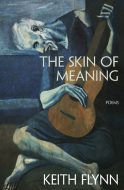 Keith Flynn
Keith Flynn
The Skin of Meaning
Red Hen Press
Reviewed by David E. Poston
Keith Flynn might be the love child of William Blake and Etta James. In his latest collection, The Skin of Meaning, he moves easily from whisper to croon to full-throated growl. As in his five earlier collections, he shows his skillful use of alliteration and brilliant mastery of the vowel register. Most of the poems are cast in unobtrusive forms and conventional stanzas that allow the exuberant language and linguistic acrobatics to do their work. This collection has the breadth of vision and associative leaps across history, art, politics, and music that one has come to expect from Flynn. What I grew to appreciate most about it, though, was the profound level of engagement these poems demanded and consistently rewarded.
The longer poems show Flynn’s ability to sustain intensity while extending his tropes, most notably by the prevalence of enjambed lines that sweep the reader along in a torrent of images. “Baby Boomers,” for example, begins with an all-too-familiar lament that
We’re at the age where half our lives
are spent practicing the acquired ritual
of watching the older ones die …
Though it continues to focus on mortality, it moves to a transcendent close with
There’s nothing better than to eat
something sweet by the sea
even in this winter or especially then
pistachio and sugar baklava
in a Styrofoam shell
thin layers of honey dough
and frothing salt waves fill the air
with warm flakes making
the boardwalk faces turn and follow
in your fragrant wake
“Broken into Light” moves in the same surrealistic rush, asking
what junk does the suffocated spirit
find necessary as we hurtle across the
galaxy at 220 kilometers per second?
Atoms and planets and blizzards and
bee, the trillions of black holes sucking
water down the toilet, the praying mantis
that bites off the head of her suitor, does
she see, in her limited lonely view, a galaxy
of possibilities …?
“House of Dance and Feathers,” another of the longer poems, explores the meaning of heaven and hell, of grace and salvation, and of being and time. The opening section, in which it is found, is appropriately named “Etymologies.” The collection’s title poem both presents and obscures its narrative of heartbreak and regret, sailing across vivid surface imagery but not revealing its “hidden realities so carefully furrowed.” “Prayer,” one of a series of nature poems, explores the sacred in the red spruce trees of Cremona, Italy, and the beautiful music formed from their “ageless swaying trunks.” The section ends with a series of poems defining the current political climate, culminating with “Gaslight: Inauguration Day.”
The two sections that follow, “Dichotomies” and “Necrologies,” present visionaries and seekers, artists and saints, varieties of genius in every field of human endeavor. They include Gaudi, Foucault, Jack Spicer, Villon, Jean-Michel Basquiat, and numerous other painters and sculptors. Often they are figures who pursued their passion to the point of self-destruction: Timothy Treadwell being eaten by a bear, Manolete dying in the bullring, Cicero’s eloquent tongue becoming Fulvia’s pincushion.
“Dichotomies” is marked by fluid surrealism and far-reaching allusions. The section’s first poem, “World Boogie,” confronts the dichotomies of southern experience. It travels James Brown Boulevard and Harriet Tubman Avenue, the Jefferson Davis Memorial Highway and John C. Calhoun Parkway, past country club socialites and students at Strom Thurmond High School, past casino patrons and tired cigarette girls. The poems about musicians—Robert Johnson, Howlin’ Wolf, Glenn Gould, Son House, Paul Motian—treat the pain that produced their music and their conflicted relationships with their audiences. “The Soul in Marble” explores the divine/carnal duality in Bernini’s sculpture of Daphne and his “Ecstasy of Saint Teresa.”
“Thinking, Fast and Slow” explores the dichotomy between the pace of time and our perception of it:
The careful myth
of objectivity peels
when the car brakes suddenly
and the deliberate feeling
of the mind like a glacier
slowly moving over
vast reserves of information
is jerked into paying
insurance money to terrorists
in Thailand
the domain of dice-throwing
monkeys who train fighter pilots
to love the blue flame
of their brains …
There is a similar surrealistic excess to “Fragments of a Door,” which seems intoxicated with its own sound.
In this disturbia, Disraelis of disreality,
vampires copulating with dying sharks
aboard venal yachts, and slaughterhouses
of curved cattle offering their backs
to the blade.
“Jenny Starling’s Classified Information” brings a tongue-in-cheek film noir quality to the mystery series heroine:
Lonely Super Hero sees Lovely Same.
He appeared, optimum guile, bearing pie.
Summoned by her poetry, pledged devotion.
Quickie marriage, off the beaten path;
El Paso, anal sex, blazing saddles,
Puppy love’s destruction, greet the priest.
Annul the potato, meet the parents.
Intermittent miracles amid disappointments, this life.
The third section, “Necrologies,” initially eases the intensity that builds in the last half of “Dichotomies.” “Thoughts on Easter While Digging a Grave” is the tenderest poem of the lot, tying the burial of a raccoon to Golgotha and the demise of the buffalo. “Look for Me in Liberia,” spoken in the voice of Nina Simone, brings that intensity back with an unflinching boldness:
The fugue
and counterpoint
makes a high priestess
soul sound
sophisticated
and if they
can’t learn to listen
I’ll quit
Fuck it …
The syncopation of this passage from “Ceremony” is particularly appealing.
… It ain’t the love
that gets you killed, it’s the letter,
not the spike that wins the point,
it’s the setter, the machinations
of the tapping shoes, accompanied
by piano, go tipping down the
wrong dark alley, just to help
a friend …
There is much more to admire here, from the sensory extravagance of “Death Trek” to the dense horror of “Antietam.” “Houdini and the Dead Letter Office” is filled with eerie and intriguing images of frosted voices, unruly labyrinths, and burning monks that for me evoke Lincoln in the Bardo.
A number of these poems comment astutely on Flynn’s poetic vision. In “Tending the Plow” we find this metaphor for craft:
So long as you
tend to the sweet singing, let the scythe
blade ring, and
massage all the stubborn edges into a
fine whistling line.
“The Kick of Infinity: Paradoxical Architecture” provides this artist’s statement:
The paramount narrative exists
in a parallel dimension sifting
among emotional sea surges
just as a poem must begin
in the thicket of the mind’s
predicament without benefit
of a sensible back story.
“Tranquility & Tremolo” describes poets as
… fractured and unfulfilled,
walking on the fragments of language like a child
measuring the steps upon rocks across a river.
Yet Keith Flynn seems anything but unfulfilled. He is a poet aware of what he wants to accomplish aesthetically and in full command of the tools to present his vision. In his essay “The Poet,” Emerson described the goal of every poet as “… to express [one’s self] symmetrically and abundantly, not dwarfishly and fragmentarily.” The poems in The Skin of Meaning accomplish that. They are vibrant, daring, compassionate, and provocative, presenting what Emerson called a “beauty not explicable.” They yield new discoveries of consequence with each reading.

